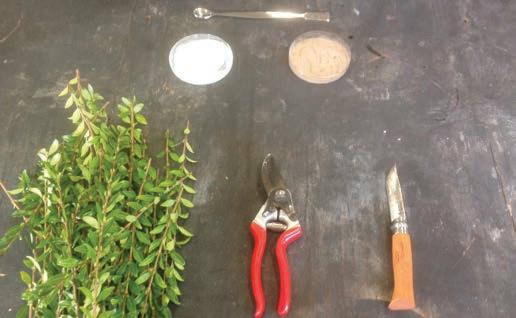14 / RESEARCH
Mycorrhizal and root
initiation and development As part of our continued drive to promote and communicate horticultural research conducted by Irish students, we’re delighted to share the work completed by Institute of Technology Blanchardstown student Paul Dunlea on mycorrhizal fungi
T
he word ‘mycorrhiza’ was originally derived from the Greek words ‘mycos’ meaning fungus and ‘rhiza’ meaning root and was first adapted in 1885 by the German researcher Albert Bernhard Frank. Mycorrhizal fungi co-evolved with the colonisation of plants on land and have remained morphologically unaltered for approximately 450 million years. It is thought that as many as 90% of all plant species now live naturally in mutualistic symbiosis with soil fungi. Symbiosis is the term used to define two or more organisms living together, with both receiving benefits from the association. The symbiotic relationships between the plant and fungus are often referred to as mycorrhizal associations and are essential to the biology of the majority of plants within the environment. This relationship benefits both the plant and the fungus through the exchange of carbohydrates and other nutrients from the plant to the fungus while providing the plant with an enhanced capability to absorb water and nutrients. As plants inoculated with mycorrhizal fungi are known to have greater absorption of micro and macronutrients and water, they have reduced requirements for irrigation and fertiliser application. Inoculated plants tend to be healthier and more vigorous and therefore have a greater ability to resist pathogens such as pests and diseases. Mycorrhizal fungi are classified into two major groups: ectomycorrhizal and endomycorrhizal fungi. Ectomycorrhizal (ECM) associations make up approximately 20% of all mycorrhizal associations. ECM fungi are a group of mutualistic root symbionts that provide nutrient uptake and increased resistance
to drought and stress, and in return the fungus receive carbon from the host plant. ECM do not enter the root cells or vascular bundles, instead the fungus penetrates the root cortex forming a sheath of septate hyphae around the entire root surface, replacing the root hairs and root cap. The hyphae form an intercellular network between the root cortex cells, known as the Hartig net, which is responsible for nutrient exchange between the fungus and plant. Endomycorrhizal fungi, also known as arbuscular mycorrhizal fungi, are the most common type of mycorrhizal association formed by the majority of horticultural crops. Endomycorrhizal fungi do not change the gross morphology of the host roots. During the infection process, the chlamydospores (thickwalled vegetative cells that function like a spore) in the soil germinate close to the plant roots. As they penetrate the epidermis of the roots, irregular mycelia develop between the cells of the root cortex. Hyphal coils, or peletons form within the cells of the outer cortex. As the fungus penetrates the parenchyma cortex, structures of special branched haustorium called arbuscules develop intracellularly. These arbuscules act as the site of carbon exchange to the fungus, and nutrient and water exchange to the host plant. Vesicles are either produced intracellularly or intercellularly and act as a storage structure containing lipids. As the fungus colonises the plant’s root system, a network of branches called hyphae (long white filamentous branches of vegetative growth) is extended into the soil surrounding the plant roots. The hyphal network
replaces the function of the plant’s root hairs, extends the plant’s root system and increases the plant’s ability to absorb water and additional nutrients, primarily Phosphorus and Nitrogen. In return the fungus obtains carbohydrates and other nutrients from the plant. As part of my undergraduate thesis in the Institute of Technology Blanchardstown, I undertook a project to determine whether using mycorrhizal fungi, rooting hormone or a combination of both was most beneficial in aiding root initiation and root development of semi-hardwood cuttings during propagation. I decided to focus my thesis on this topic as I have keen interests in the various aspects of plant propagation and the research involved in order to improve the efficiency of nursery stock production. For the purpose of the experiment, 360 semi-hardwood cuttings of Lonicera pileata (privet honeysuckle) were prepared, divided into four groups and subjected to one of the following treatments; mycorrhizal fungi inoculum (containing both endomycorrhizal and ectomycorrhizal fungi), rooting hormone, a combination of mycorrhizal fungi inoculum and rooting hormone and the control (no treatment application). All cuttings were placed on a warm bench in a randomised block design and covered with a polythene sheet for the duration of the experiment. The purpose of the experiment was to determine which of the four treatments would provide the most positive results in terms of rooting initiation, percentage of cuttings rooted, root length, root ball diameter and fresh and dry root weights, just six weeks after initial propagation. The rationale for the project was to assess the many benefits of
Autumn/Winter 2016 / www.horticulture.ie / HORTICULTURECONNECTED
45











